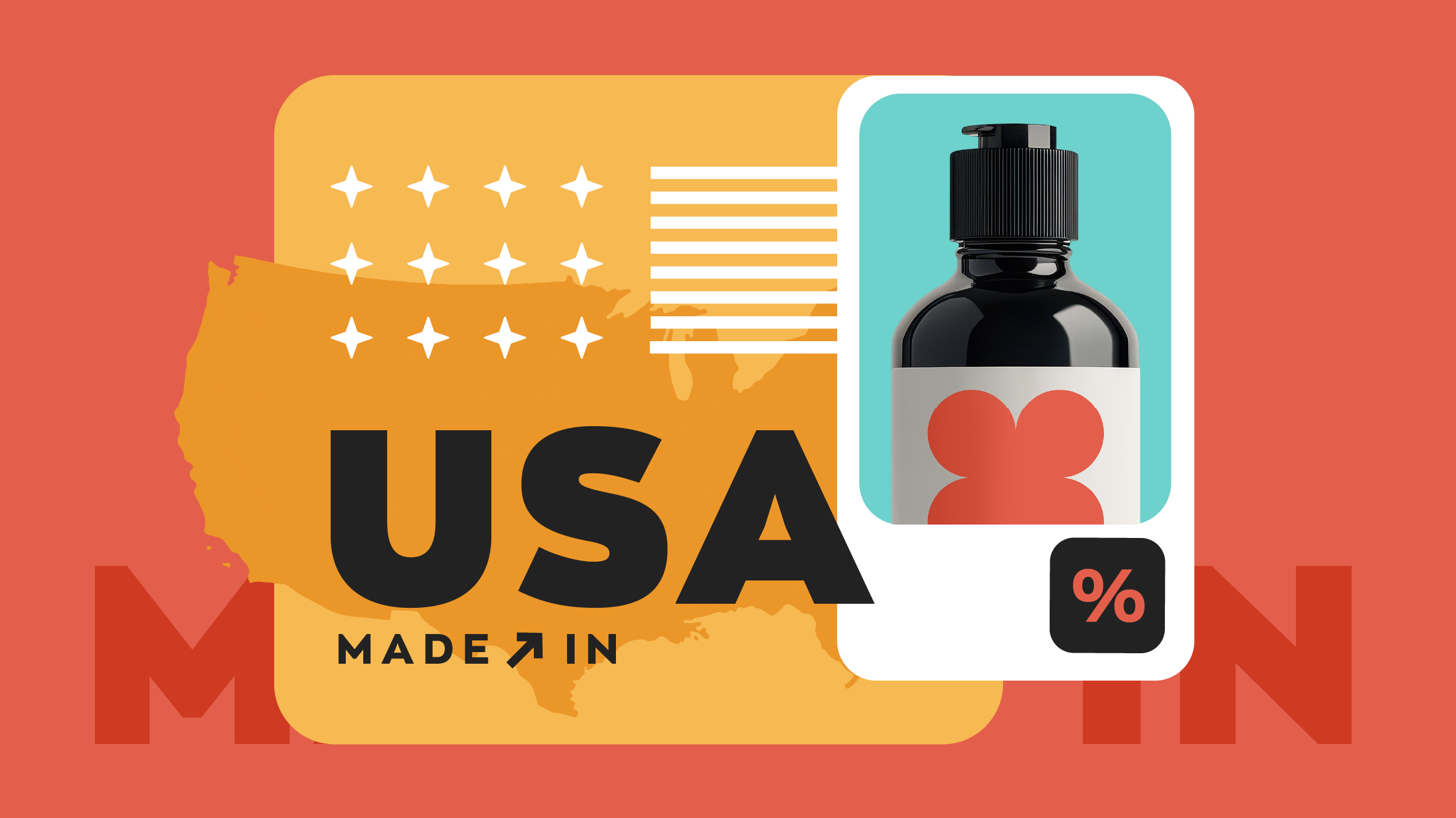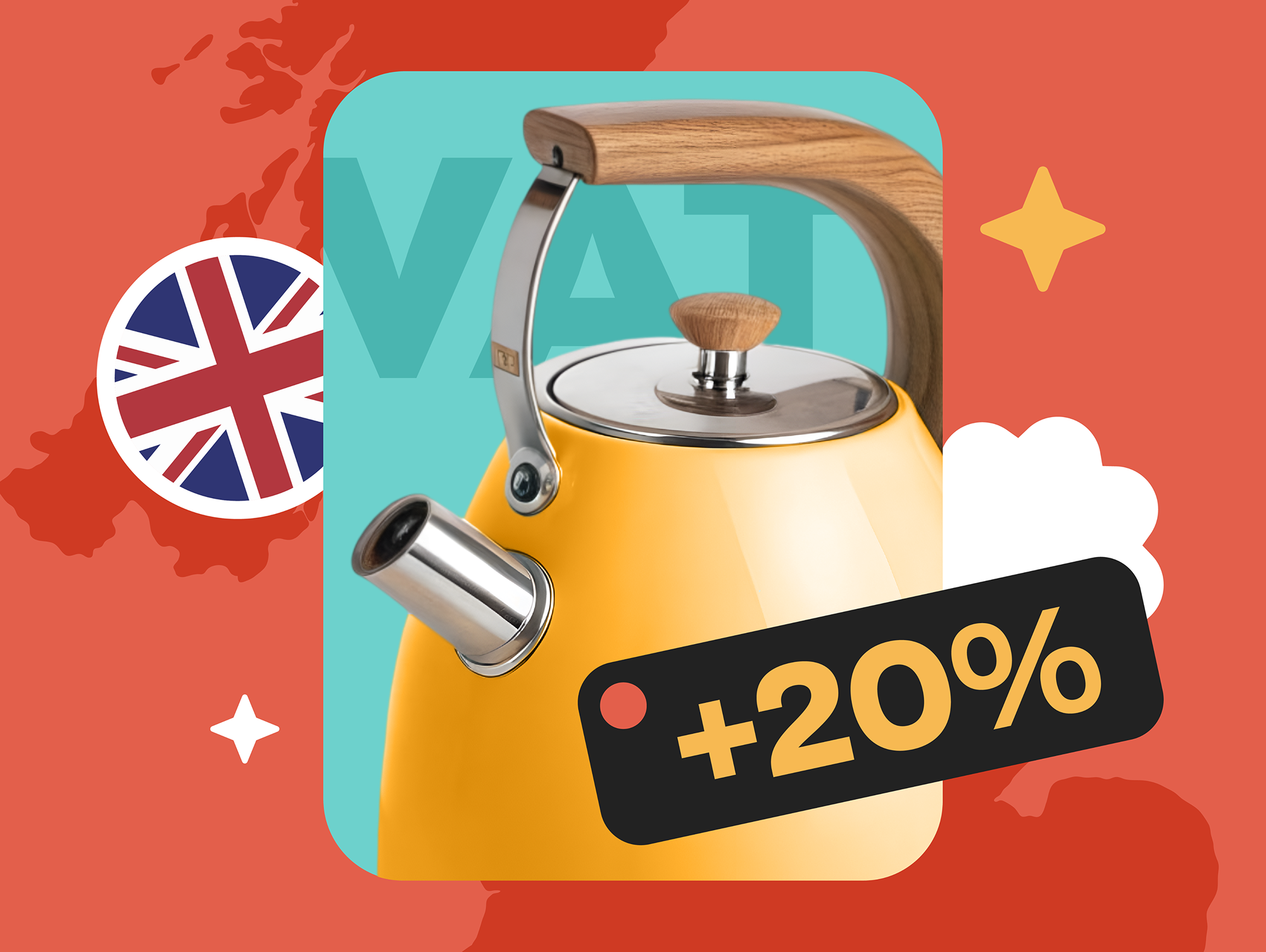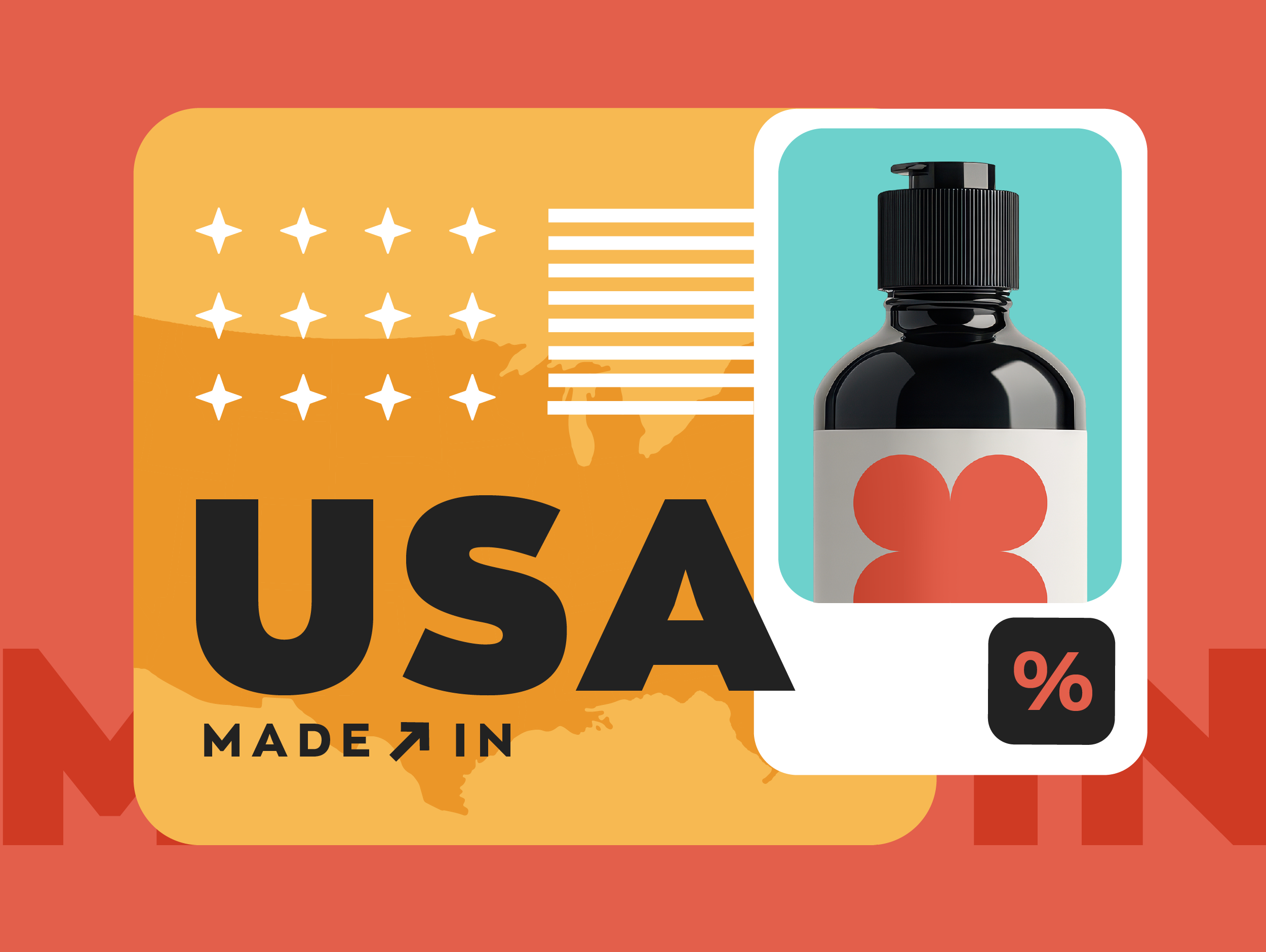Policy shifts in today’s polarized economy don’t just spark debates; they shape our buying behavior. As new tariffs are proposed and rolled out, Americans are having to choose between supporting domestic manufacturing and stretching their paychecks. Are tariffs a patriotic policy or just a new tax on the middle class?
To uncover the reality, we surveyed 1,000 American consumers nationwide about how tariffs, prices, and product origins influence their decisions at checkout. The results reveal generational divides, surprising priorities, and a clear message for businesses and policymakers alike: most Americans want to support U.S.-made goods, but not at any cost.
Key takeaways
- If grocery prices jump due to tariffs, 88% of Americans say they’ll change how they shop, 1 in 3 will cut back, and another third will switch to cheaper brands.
- Despite claiming to care about product origin, 9 in 10 Americans don’t check where items are made before buying.
- 1 in 3 Americans expect companies to absorb tariff costs instead of raising prices on consumers.
- Less than 1 in 5 Americans support tariffs to create jobs if it means higher prices on essentials like groceries.
- Only 30% believe tariffs are really about creating American jobs, most say they’re political tools or just a way to raise revenue for the government.
- More than half of Americans (54%) are willing to pay up to 10% more for U.S.-made goods — but if prices get any higher, most walk away.
- 8 in 10 Americans say the U.S. needs to reduce reliance on other countries to protect its own economic security.
- 52% of Americans buy U.S.-made products to support American jobs, not out of patriotism.
- Only 1 in 4 Americans believe tariffs are an effective way to boost U.S. production and economic independence.
- 3 out of 5 Americans think tariffs will harm the economy in the grand scheme of things, causing higher prices and trade hostility.
How important is “Made in the USA”? Over half have bought American, but many won’t pay extra
68% of Americans say buying U.S.-made goods is key to supporting the economy, but younger generations aren’t sold.
Support peaks among baby boomers (78%), then drops steadily: 66% of Gen X, 60% of millennials, and just 54% of Gen Z consider it a priority.
But saying you support American-made and spending accordingly are two different things. When faced with a cheaper imported option, who still chooses Made-in-America products?
- Baby boomers: 81%;
- Gen X: 71%;
- Millennials: 73%;
- Gen Z: 62%.
Americans may support “Made in the USA,” but their wallets set the limit.
While 54% are willing to pay up to 10% more for domestic goods, only 17% would go beyond that. And for 1 in 3 shoppers, price is the only thing that matters; origin doesn’t even cross their mind.
Americans buy domestic to protect jobs, not wave flags
For one in two Americans, buying U.S.-made goods is about protecting jobs and supporting the country’s economy. Only a mere 4% do so in the name of patriotism.
At its core, the push to “Buy American” ultimately reflects deeper economic worries. 81% of Americans believe cutting reliance on foreign nations is essential to safeguarding the U.S. economy.
Tariffs 101: Familiar, but divisive
9 in 10 Americans may understand what tariffs are, but they certainly don’t agree on whether they’re a good thing.
1 in 2 Americans think tariffs are a bad idea, especially for consumers. 52% are concerned tariffs drive up prices, while only 1 in 3 see them as a way to boost economic independence.
Gen Z and the wealthy agree: tariffs are worth it
Despite not being as financially established as older generations who have had time to build up wealth and security, Gen Zers show the highest support for tariffs (36%). Baby boomers aren’t far behind, at 33%, while Gen X are the strongest opponents at 25%.
Higher earners tend to favor tariffs, while lower-income Americans are far more skeptical. 67% of those earning $150,000 or more say tariffs are beneficial and show no concern about rising prices.
But for those making less than $50,000 a year, support plummets to just 24%, reflecting the greater financial strain they face from tariff-driven price increases.
Groceries 20% more expensive at the checkout? 31% would switch, 25% want tariffs gone
A 20% price spike from tariffs would prompt nearly 9 in 10 Americans to change how they shop, and just 12% would accept the cost increase.
Generational responses show even sharper contrasts. 37% of baby boomers say they’d cut back overall spending, while younger Americans are more likely to adapt: 34% of Gen X and millennials would switch to cheaper products, along with 54% of Gen Z.
That said, baby boomers are the most likely to take political action; 29% would lobby for tariff removal. And despite having a reputation for being politically active and socially conscious, only 15% of Gen Z would do the same.
In response, companies dealing in necessities like clothing or groceries can diversify and track their inventory to ensure they have a variety of domestic and overseas products to give consumers more choices.
Consumers want companies to eat the cost
After all, when tariffs hike prices, Americans don’t just adjust their behavior. They expect businesses to act, too.
If tariffs drive prices up by 30%, nearly half of Americans want companies to move manufacturing to the U.S. to avoid the added costs. One in three expect businesses to absorb the increase, while only 18% think those costs should be passed on to consumers.
Historically, companies typically either pass costs on to consumers or stop importing unprofitable products. And domestic manufacturing could pick up that slack, but that requires investing in infrastructure and increasing hiring to meet demand. For many small businesses, such investments simply aren’t feasible. Except for well-funded corporations, expecting companies to shoulder the burden of tariffs isn’t realistic.
Ethics and environment: Nearly 3 in 4 Americans consider the broader impact of their purchases
Conscious consumption has captured the conscience of Americans, with 73% considering the ethical implications of their purchases.
Whenever they buy a low-priced foreign item, Americans think about its creation. Were workers paid fairly? Did they work in safe conditions? Did creating the product harm the environment? Did shipping it overseas?
Chances are, no, but that’s exactly what makes these products so affordable to American consumers and what allows corporations to make incredible profits.
If more manufacturing moves back to the U.S., products are going to be made more ethically — in safer environments, where workers are better paid and environmental regulations are stricter — but they’re also going to cost more, and it’s unclear whether Americans can afford to pay those prices.
Of course, caring is easy. Action is hard.
Just 15% of Americans actively seek out ethical products. So while 58% say ethics matter, convenience and cost still win out.
Will Americans keep buying if goods are sourced unethically?
Only 42% would stop buying a product if they found out it was produced unethically. Even though ethics may be important, they clash with price tags and convenience.
- 42% would stop buying the product.
- 29% would consider cheaper alternatives, but ultimately make a decision based on price.
- 23% would delay a decision until they had more information.
- 7% would continue buying a product regardless of the ethical issues.
Ethical shopping divides generations. 50% of baby boomers would stop buying from an unethical brand, while just 25% of Gen Z say the same.
Nearly half of Gen Z (48%) would still choose the cheaper option, even if it came with ethical concerns. Despite being the most ethically aware generation, Gen Z is often limited by cost, highlighting a gap between values and action.
Americans may rationalize, and even accept, their purchases, but they don’t feel good about them. They’re nearly twice as likely to feel guilty about buying unethically sourced products (64%) as they are to feel no guilt at all (36%).
However, guilt isn’t enough to overcome the ever-rising costs of ethically produced goods.
American bias
Only 40% of Americans think U.S.-made products are produced in ethical working conditions, despite having stronger labor laws and union protections.
- 40% of people express the belief that U.S.-made products are more likely to adhere to ethical standards and be produced in fair labor environments.
- 35% remain unsure, suggesting their perception depends on the specific product or the company behind it.
- 25% hold the view that U.S. products are not necessarily more ethical than those produced elsewhere.
After all, ethical labor doesn’t always mean ethical impact, and concerns about environmental harm, pollution, and climate change may erode trust in domestically made goods.
Checking the label: More than 1 in 3 rarely or never look when shopping online
Ethical shopping often requires one thing most people don’t have: time. Features like one-click checkout make it easy to skip the research, and most Americans admit they don’t dig deep before hitting “Buy Now.”
- 9% of people always research the products they buy online.
- 56% check product information, but not for every purchase.
- 35% of people don’t do any research.
The same dynamic is at play when it comes to checking where products are made:
For many, the “Made in the USA” label signals quality and trust but those assumptions are increasingly questioned. After all, products with this label may be designed in the U.S. but actually created elsewhere.
While official designations are regulated, many origin claims slip through loopholes, leaving consumers wary. Marketers know the power of patriotic branding and many aren’t afraid to blur the lines to boost appeal to the 68% of Americans who want to support the economy through their domestic purchases.
Most consumers are aware of this possibility:
The result? A retail environment where values-driven shoppers must navigate not just price and convenience, but murky claims and mixed signals.
30% import premium? Over 40% say “No thanks,” even if it means American jobs
When American-made products come with a 30% higher price tag, 91% of consumers hesitate or outright refuse to buy them.
- 47% say their decision depends on their finances at the time of purchase.
- 44% can’t justify such a high price increase.
- 9% are willing to financially sacrifice for U.S. businesses.
For some, it may depend on what it is they’re buying. 46% of Americans wouldn’t support tariffs on necessities like groceries, even if it eventually led to more American jobs. For others (35%), it depends on how much prices rise. And only 19% support tariffs in the name of creating more American jobs.
Tariffs are supposed to level the playing field for domestic manufacturers in a market flooded with cheap imports. But many Americans wouldn’t be so quick to jump on the made-in-USA bandwagon, even with price hikes on foreign goods.
The bottom line? It’s about the bottom line. Americans care about supporting U.S. jobs, but only so much. When costs surge, the reality of life pushes ideals to the wayside.
Tariffs on our neighbors: Nearly 60% blame the U.S. government for rising costs
3 of 5 believe tariffs ultimately do more harm than good for the economy, with only 25% believing they help. Stress, frustration, and uncertainty over these harmful effects are all fueling this fire:
Tariff anxiety cuts across generations and income brackets. However, Gen Z is especially concerned about this issue, with 64% citing it as their biggest worry, followed closely by 60% of baby boomers, compared to about 50% of Gen X and millennials.
This fear plagues even high-income families. 59% of Americans earning at least $150,000 fret over price hikes more than anything else — almost identical to the 56% of Americans bringing in less than $50,000.
If tariffs do cause price spikes, Americans are primed to point fingers, particularly at the government.
Ultimately, the government is incentivized to get positive results from tariffs or they risk facing the political backlash of financially strained consumers.
Why tariffs on Canada and Mexico?
Trade between the U.S., Mexico, and Canada has long been governed by sweeping agreements from NAFTA in 1994 to the more recent USMCA in 2020. But President Trump’s tariff threats and policies disrupted that foundation, leaving many Americans questioning what those taxes were really about.
And for many, it’s not about trade at all. Here’s what Americans believe the tariffs are really for:
- Punishment for immigration and drug trafficking: 31%;
- Creating more American jobs: 30%;
- Generating revenue for the government: 29%;
- Something else entirely: 27%;
- Protecting national security: 14%.
The wide range of beliefs reflects the volatile nature of the Trump-era tariff landscape, marked by shifting justifications, sudden rollbacks, and evolving rhetoric. But it also highlights something deeper: Americans aren’t sure who these tariffs help, or whether they help at all.
Yes, most Americans grasp the basic concept of tariffs. But few are willing to pay the price when it hits their bottom line and many remain skeptical that these taxes will meaningfully strengthen the U.S. economy.
For now, the takeaway is clear: While “America First” tariffs were designed to protect, they’ve left many consumers feeling uncertain, unconvinced, and stuck footing the bill.
Methodology
For this study, we took data from 1,000 American consumers. To get an accurate picture, we included people from different states, age groups, and income brackets. We analyzed the response data using these factors and others, including location (region of the country) and gender.
Finally, our questions covered both general purchases and necessities like groceries. This approach helped us pinpoint any differences between spending on needs and non-necessary items.
Fair use policy
Users are welcome to use the analyses and findings from this study for noncommercial purposes, such as academic research, educational presentations, and personal reference. However, when referencing or citing this article, please ensure proper attribution. Direct linking to this article is permissible and encouraged to provide readers with access to the primary source.
For commercial use or publication purposes — including but not limited to media outlets, websites, and promotional materials — please contact the authors for permission and licensing details. We appreciate your respect for intellectual property rights and adherence to ethical citation practices. Thank you for your interest in our research.





0 Comments